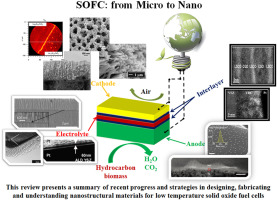Nano Energy ( IF 17.6 ) Pub Date : 2017-12-29 , DOI: 10.1016/j.nanoen.2017.12.044 Liangdong Fan , Bin Zhu , Pei-Chen Su , Chuanxin He

|
Solid oxide fuel cells (SOFCs) show considerable promise for meeting the current ever-increasing energy demand and environmental sustainability requirements because of their high efficiency, low environmental impact, and distinct fuel diversity. In the past few decades, extensive R&D efforts have been focused on lowering operational temperatures in order to decrease the system (stack and balance-of-plant) cost and improve the longevity of operationally useful devices of commercial relevance. Nanomaterials and related nanotechnologies have the potential to improve SOFC performance because of their advantageous functionalities, namely, their enlarged surface area and unique surface and interface properties compared to their microscale analogs. Recently, the use of nanomaterials has increased rapidly, as reflected by the exponential growth in the number of publications since 2002. In this work, we present a comprehensive summary of nanoparticles, nano-thin films and nanocomposites with different crystal phases, morphologies, microstructures, electronic properties, and electrochemical performances for low temperature SOFCs (LT-SOFCs), with focus on efforts to enhance electrical efficiency, to induce novel fundamental properties that are inaccessible in microcrystalline materials, and to promote the commercialization of LT-SOFCs. Recent progress in the applications of many classically or newly chemical and physical nanomaterials and nanofabrication techniques, such as thin film vacuum deposition, impregnation, electrospinning, spark plasma sintering, hard- and soft-template methods, and in-situ nanoparticle surface exsolution are also thoroughly described. The technological and scientific advantages and limitations related to the use of nanomaterials and nanotechnologies are highlighted, along with our expectations for future research within this emerging field.
中文翻译:

低温固体氧化物燃料电池的纳米材料和技术:最新进展,挑战和机遇
固体氧化物燃料电池(SOFC)效率高,对环境的影响小,燃料种类独特,因此有望满足当前不断增长的能源需求和环境可持续性要求。在过去的几十年中,大量的研发工作一直集中在降低操作温度上,以降低系统(烟囱和工厂平衡)成本并提高具有商业意义的可操作使用设备的使用寿命。纳米材料和相关的纳米技术具有潜在的改善SOFC性能的潜力,因为它们具有优越的功能性,即与微米级类似物相比,它们具有更大的表面积以及独特的表面和界面特性。最近,纳米材料的使用迅速增加,自2002年以来出版物数量的指数增长反映了这一点。在这项工作中,我们提供了具有不同晶相,形态,微观结构,电子性能和低温电化学性能的纳米颗粒,纳米薄膜和纳米复合材料的综合摘要。 SOFC(LT-SOFC)致力于提高电效率,诱导微晶材料无法获得的新的基本性能,并促进LT-SOFC的商业化。在许多经典或新的化学和物理纳米材料以及纳米制造技术(例如薄膜真空沉积,浸渍,静电纺丝,火花等离子体烧结,硬模板和软模板方法)的应用方面的最新进展,还详细描述了原位纳米颗粒的表面提取。与纳米材料和纳米技术的使用相关的技术和科学优势与局限性,以及我们对这一新兴领域未来研究的期望都得到了强调。



























 京公网安备 11010802027423号
京公网安备 11010802027423号